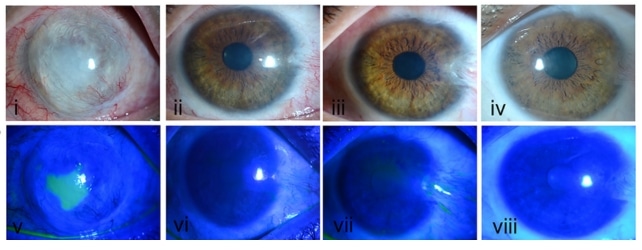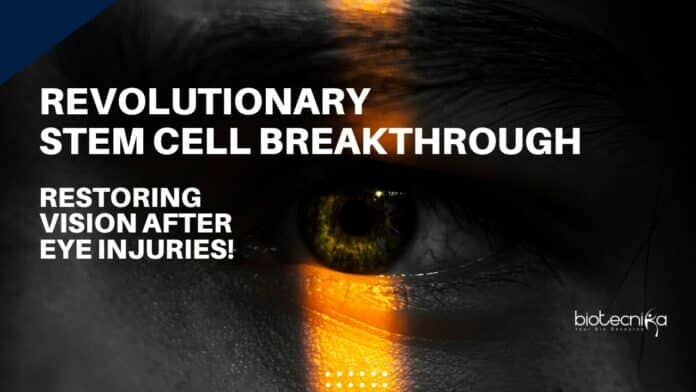Stem Cell Breakthrough – Innovative Stem Cell Therapy Shows Promise in Restoring Vision Following Eye Injuries
A groundbreaking phase 1 clinical trial centered around utilizing a patient’s own stem cells has displayed encouraging early outcomes in the restoration of vision for individuals who suffered severe chemical burns to one eye.
A team of researchers from the United States revealed that even without additional interventions, two out of the four patients exhibited noteworthy enhancements in their vision after a year of follow-up. Notably, the remaining two patients became eligible for corneal transplant procedures, a possibility that was previously ruled out due to the extent of their injuries.
Ula Jurkunas, an ophthalmologist affiliated with Massachusetts Eye and Ear and the lead author of the study, expressed optimism, stating, “Our initial findings propose that this treatment might provide a ray of hope for patients who had previously faced the bleak prospect of irreversible vision loss and the associated pain stemming from severe cornea injuries.”
The novel technique involves creating a tissue graft using a small biopsy of stem cells sourced from the patient’s healthy eye. Known as cultivated autologous limbal epithelial cell (CALEC) transplantation, this procedure sidesteps the risk of rejection often associated
with other methods, given that the cells are obtained from the patient’s own body.
These specialized cells are harvested from the limbus, which constitutes the outer corneal perimeter of the healthy eye. Limbal stem cells play a pivotal role in maintaining the cornea, the transparent outer layer that initially captures incoming light. The smoothness of this layer is essential for achieving clear vision.
In instances of chemical burns to the eye, the limbal region frequently sustains irreparable damage, rendering the normal regeneration of new cells impossible.
Common approaches to address eye damage often involve transplanting a healthy cornea from a donor eye. However, these procedures require functional limbal stem cells and a healthy eye surface to support the transplanted corneal tissue, making them unsuitable for individuals with substantial damage.
Other alternatives encompass the use of donor limbal tissue grafts, which can pose infection risks, or transplanting a larger portion of healthy eye cells directly onto the injured eye. Nevertheless, this latter option risks impairing the growth of limbal cells in the healthy eye, which is far from an ideal compromise.
The innovative approach described in this study employs a minimal quantity of healthy eye stem cell tissue, which is cultivated into a larger cell layer capable of fostering the regeneration of healthy tissue once transplanted onto the injured eye’s surface.
Once a healthy surface is reestablished, these patients can undergo a conventional corneal transplant, a step that some participants in the phase 1 trial did not require.
The study involved four male patients aged between 31 and 52. While one patient did not experience enhanced vision following CALEC transplantation, his eye surface did heal, subsequently enabling him to proceed with a cornea transplant.
Another participant encountered an initial setback when an initial biopsy failed to yield a viable stem cell graft. However, three years later, a second attempt at CALEC proved successful. His vision progressed from perceiving hand motion to being able to discern fingers, and he also became a candidate for a cornea transplant.
Stem Cell Breakthrough
Remarkably, the remaining two patients achieved substantial progress, achieving 20/30 vision, obviating the need for a corneal transplant altogether.
Biopsies were conducted on the healthy eyes of five patients. Unfortunately, one patient could not undergo CALEC transplantation due to limited stem cell expansion. Crucially, the eyes of all five patients that underwent biopsies healed without complications, and their vision was restored within a span of four weeks.
The dearth of high-safety treatment options for individuals afflicted with chemical burns and other injuries that preclude cornea transplants has posed challenges for cornea specialists, as underscored by Jurkunas.
Presently, researchers are in the final stages of the subsequent phase of the clinical trial involving CALEC patients, a cohort they have been monitoring for 18 months. These endeavors are aimed at gaining a more comprehensive understanding of the overall efficacy of the procedure.
Jurkunas expressed optimism for the future, stating, “With continued investigation, we aspire for CALEC to eventually bridge this crucial treatment gap that is currently unmet.”
Stem Cell Breakthrough – latest news



























